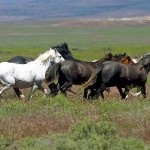July 31, 2010 – CHICAGO, (EWA) – The National Conference of State Legislators (NCSL) has passed a resolution calling for the reinstatement of USDA inspectors for horse meat.
The NCSL is a non-governmental lobbyist organization which serves the nation’s 50 states legislators to advocate and lobby for the interests of states before Congress and federal agencies. The resolutions NCSL passes are not binding and merely allow them to lobby on behalf of the states.
Representative Sue Wallis (WY), who is vice chair of the NCSL’s Agriculture and Energy Committee, went on record asking that she be allowed to slaughter horses to feed Wyoming children, the poor and prison inmates without having the meat federally inspected for consumer safety. The Wyoming livestock board responded quickly by stating in no uncertain terms that “horse slaughter is not an option.”
The Equine Welfare Alliance (EWA) strongly opposes the misuse of tax payer dollars to fund inspections for an industry that is not needed or wanted by the overwhelming majority of Americans.
Continue reading Lobby Group Will Urge Congress to Fund Export of Tainted Horse Meat

